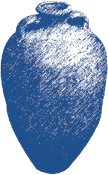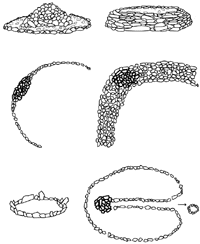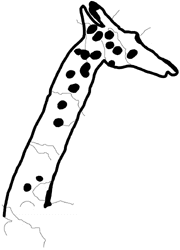| Contents
Abstracts |
Abstracts of Sahara volume 17
(published June 2006)
|
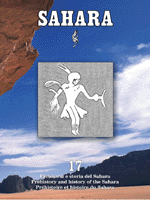
|
John A. Seeger, Steven E. Sidebotham, James A. Harrell and Michel Pons
A brief Archaeological Survey of the Aqiq region (Red Sea Coast), Sudan
ABSTRACT
A brief survey of the region around the village of Adobana, south of Aqiq on the Red Sea coast of Sudan, recorded structures buried by extensive sedimentation and associated Islamic period pottery as well as fluted «classical» type column drums recycled into other structures or standing alone in the village. Cemeteries and individual graves north of Adobana appeared to be pre-Islamic in date. Bahdur (Ibn Abbas) Island, adjacent to the coast opposite Adobana, preserved the remains of a number of buildings, one of which was quite large, two Muslim era cemeteries and a series of rock-cut cisterns of unknown date. Examination of another nearby island, Farrajin, revealed some Islamic pottery and glass fragments, but no architectural remains. Neither epigraphic nor other information provided any clue as to the identities of the remains at Adobana or Bahdur Island.
|
|
Top
|
Ashten R. Warfe
Reconsidering the argument for an early Holocene pottery tradition in Dakhleh Oasis, central Western Desert, Egypt
ABSTRACT
One of the findings in Hope’s (2002) recent study on the prehistoric ceramics from Dakhleh Oasis was that pottery-production began in the region some time during the early Holocene period. This conclusion is at odds with studies conducted in neighbouring regions, where the earliest evidence for pottery-production dates to the eighth millennium bp. In this paper, Hope’s argument for an early Holocene pottery tradition in Dakhleh is reconsidered in light of two points. One of these is that pottery-production does not fit the ‘organisational’ profile of the early Holocene inhabitants of the oasis. The other point concerns newly excavated material, which indicates that the pottery finds could be intrusive to early Holocene sites. This paper reaches the conclusion that pottery-production was unlikely to have occurred in the oasis during the early Holocene period.
|

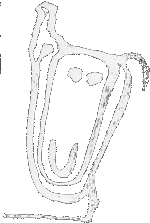
Top
|
Christian Dupuy
L’Adrar des Iforas (Mali) à l’époque des chars: art, religion, rapports sociaux et relations à grande distance
ABSTRACT
Contextual study of eighty-one depictions of complete or partial chariots, engraved on exposed rock faces located along the edges of six neighbouring valleys on the north-western flank of the Adrar des Iforas. All the chariots have only one shaft, and the majority do not appear to be yoked. The few vehicles which are, are pulled by a couple of oxen, side by side. Curiously, none of the harnessed chariots has a driver. The driver’s absence, combined with the location of the engravings on rocks not visible by passers-by, their bare style and the non-narrative vocation of associated expressions, together argue towards these works of art being dedicated to supernatural beings. The predominance of taurine figures in all these sites seems to indicate their primordial role on a symbolic level, and their correlated essential function in social exchange. Furthermore, parietal art demonstrates the transmission of beliefs and the circulation of luxury goods throughout the Sahara during the 2nd millennium B.C. The original architecture of some of the chariots suggests the existence of cartwrighters’ workshops to the west of the Nile Valley, perhaps as early as the 16th century B.C. The first millennium B.C. is characterized by the advent of a new ideology and the outlines of human figures, sometimes imposing and armed with spears, come into prominence. An exotic animal so far ignored by artists makes a timid appearance: the horse.
|
|
James A. Harrell and Mohamed I. Madbouly
An ancient quarry for siliceous sandstone at Wadi Abu Aggag (Egypt)
ABSTRACT
A reconnaissance survey was conducted of a previously unstudied quarry for siliceous sandstone located on the east bank of the Nile River, just north of Aswan (Egypt) and near the valley of Wadi Abu Aggag. This rock was widely used in ancient Egypt for statuary, sarcophagi, stelae and many other carved objects. Wadi Abu Aggag is one of only three known quarries for siliceous sandstone in Egypt, and at 3.9 km2 is the largest in terms of the area covered by continuous workings. Archaeological remains in the Wadi Abu Aggag quarry date to the New Kingdom, especially the 18th and 19th dynasties, and also to the Roman period. These include graffiti (some with hieroglyphic texts), roughed-out statue blanks, pottery, stone huts and rock shelters, a paved slipway, hundreds of quarry pits, stone pounders, and worked bedrock surfaces exhibiting distinctive New Kingdom and Roman tool marks.
|
|
Top
|
Robert Vernet, Alain Rodrigue et Philippe Tous
Les tests d’œuf d’autruche gravés au littoral atlantique saharien:
du nord du Banc d’Arguin à l’oued Draa
ABSTRACT
Information on carved ostrich eggshells in north-western Sahara is often outdated and dispersed over a vast area, between oued Draa and the Tarfaya region in southern Morocco and to the north of Banc d’Arguin in Mauritania. New findings suggest to synthesize the present knowledge, and a definite cultural homogeneity over a long period is now clear. Chronology appears in fact to extend from the end of the 8th millennium B.P. to the 4th millennium, if not to more recent times. Decorations are organized in different groups, the most spectacular of which, from the Tarfaya region, is figurative and depicts mammals, birds, fish. Other groups are characterized by geometric motifs, for instance Et Teyyedché (7000 B.P.) and Cansado (6000 B.P.), in north-western Mauritania. Approximately a thousand carved eggshells mark the limits of two important Middle-Holocene cultural areas, in two key periods: the Epipalaeolithic, immediately preceding the Neolithic, and the Middle or even Late Neolithic, marking the peak of population density during ancient times.
|
|
Top
|
Nick Brooks, Joanne Clarke, Jon Crisp, Federica Crivellaro, Hélène Jousse, Emma Markiewicz, Matt Nichol, Margaret Raffin, Rachel Robinson, Alexander Wasse and Vicky Winton
Funerary sites in the «Free Zone»: Report on the second and third seasons of fieldwork of the Western Sahara Project
ABSTRACT
This paper synthesises the findings of three seasons of fieldwork in Western Sahara, focusing on the funerary and related archaeology of the Polisario-controlled “Free Zone”. Building on the results of a reconnaissance survey in the Northern Sector of the Free Zone in 2002, new findings from a reconnaissance survey in the Southern Sector are presented. Results from both seasons are integrated in order to provide a tentative description of the spatial distribution of stone monuments in this region. Emerging spatial patterns are described, indicating similarities but also significant differences between the Northern and Southern Sectors in terms of the archaeological record. Preliminary results from the excavation of two funerary monuments, undertaken during a third season in the Northern Sector, are also presented. These conical tumulus monuments contained articulated human skeletons and a limited variety of grave goods. The presence of metal in both tumuli suggests that they are likely to date from the first millennium BCE.
|

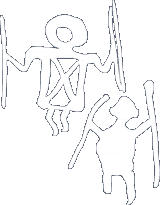
|
Malika Hachid
Du nouveau sur le monument d’Abalessa (Ahaggar, Algérie).
De la date de l’introduction du dromadaire au Sahara central, du personnage d’Abalessa et des inscriptions rupestres dites «libyco-berbères»
ABSTRACT
This paper presents some unpublished rock engravings featuring on a stone of the Abalessa monument enclosure wall (Ahaggar). The study of these engravings is important in defining the date for the introduction of camels in central Sahara, the peoples occupying the Ahaggar and central Sahara, starting from the Saharan Libyans of late prehistory up to the Sahhadja Howwara/Haggar of the Ahaggar and the Azgar of the Tantanoh/Tassili, and also adds information on the Abalessa personage. Finally, considering the great diversity of the ancient Berber peoples of central Sahara, it is more and more difficult to establish a relationship between Saharan rock inscriptions and the scenary traditionally applied by linguists, first of all between the so-called «ancient» and «recent» Abalessa tifinaghs.
|
|
Top
|
Michel Raimbault, Hélène Jousse, Alain Person et Kléna Sanogo
Deux nouvelles stations rupestres du «Camélin récent» dans le Faguibine et les Daounas (Sahel malien)
ABSTRACT
The paintings recorded in the shelters of Fondogoro island, Faguibine lake, and Tihoun Mallouline, in the Daounas, are the southernmost known in the outer fringe of the Malian Sahara. They are related to the tradition of the recent Camel period, still called «Libyco-Berber» and spreading from central Sahara, and belong to the Tuareg culture. Some quadrupeds are identified as equids, and the main scenes depict caravans on the move, with camel drivers riding dromedaries kept on a leash and details of saddles and implements. The paintings draw attention to the role of the Daounas area in the south of Faguibine as an important camel-path crossroads.
|
|
Joaquim Soler Subils, Narcís Soler Masferrer and Carles Serra Salamé
The painted rock shelters of the Zemmur (Western Sahara)
ABSTRACT
The paintings recorded in the shelters of Fondogoro island, Faguibine lake, and Tihoun Mallouline, in the Daounas, are the southernmost known in the outer fringe of the Malian Sahara. They are related to the tradition of the recent Camel period, still called «Libyco-Berber» and spreading from central Sahara, and belong to the Tuareg culture. Some quadrupeds are identified as equids, and the main scenes depict caravans on the move, with camel drivers riding dromedaries kept on a leash and details of saddles and implements. The paintings draw attention to the role of the Daounas area in the south of Faguibine as an important camel-path crossroads.
|
|
|

http://www.saharajournal.com
e-mail: reception@saharajournal.com
Last update Monday, September 2, 2013
|
|
|
|



